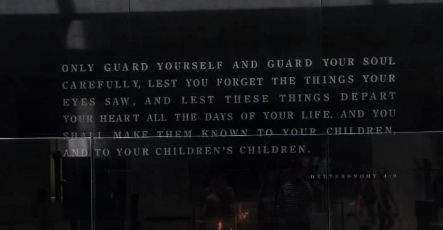Written by: Adan Garcia, Caminos al Futuro 2019
Caminos al Futuro puts an emphasis on exploring one’s culture and meditating on one’s self-identity. Today, I had the honor of visiting the United States Holocaust Memorial Museum. In short, it was a very humbling experience. Throughout the course, we’ve focused on issues plaguing our culture as Hispanics. It’s unfortunate how issues from decades ago are still problems today. One can’t compare current issues in our community to those lived out by the Jewish population in the late 1930s and early 1940s, but subtle connections can be made.
Throughout the museum, one thing was clear, their sense of identity was profound. In the last couple of weeks, questions about my identity as a Latinx community member sparked a fire inside of me. I have never been ashamed nor have I ever tried to hide my Latinidad, but I’ve never really let it flourish. Before I began to take classes with Dr.Vaquera, and Trey, I often just looked the other way when issues surrounding my community came up. It wasn’t that I was ignorant, I just never took the time to look at issues from different points of view.

An interesting topic we explored in class was questioning the boxes that we filled on official forms such as the Common App and the Census. The term Hispanic is applied to whoever identifies as Hispanic. It’s interesting how this simple assertion opens the door to more complex questions. “Should a person adopted into a Hispanic household consider themselves to be Hispanic?” “Is it ethical for someone with indigenous heritage to claim to be Native American?” These questions helped us understand how profound being Hispanic is.
Relating it back to my experience at the Holocaust Museum, I noticed how the Jewish population came from different ethnic backgrounds. Citizens that had never stepped foot anywhere near Palestine, (Israel was not recognized as a nation until after WWII) were being prosecuted for identifying as Jews. It’s hard saying there’s a connection between the way the Jewish and Hispanic population are classified without being disrespectful or not acknowledging the atrocities that the Jewish population had to go through. However, I think that this minuscule connection can be used to understand how the term Hispanic is used. Just how there were Jews living in Germany who claimed to be German and Jewish, or how there were citizens living in Africa who had connections to Jewish heritage, the term Hispanic can also be applied accordingly. There might be two very different people identifying as Hispanic on completely opposite sides of the world, with completely different races and backgrounds, but somehow, they find common ground in their ethnicity, and that’s the beauty of my Hispanidad.
Adan Garcia is a Caminos al Futuro 2019 scholar. Adan’s views are his own and not necessarily reflective of the Cisneros Institute.


